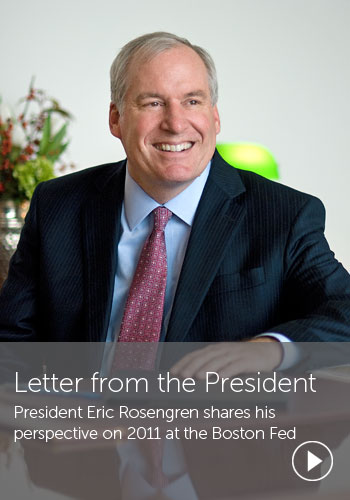Letter from the President
“Connecting” is the theme of our 2011 Annual Report.
Connecting is also a reason the report comes to you for the first time in a multimedia format. We hope the videos and information graphics make it easier than ever for you to connect with the Bank and its work and mission.
We have included three videos showing some of the ways that connections characterized our work in 2011. The vignettes tell three stories of how the Bank worked to serve the public:
- connecting with small banks in Vermont and helping them meet customers’ needs when their cash supply was affected by the flooding from Hurricane Irene.
- connecting with Latino small business owners to help identify their needs, highlight their positive role in the region’s economy, and support their success.
- working to connect the science of economics and policy analysis to the very human realities of real people in New England.
Within the Bank we saw a great deal of change in 2011. We welcomed several new senior leaders, conducted an intensive self-assessment, and put in place a new organizational structure to align ourselves for the future.
Turning to the economic situation and policymaking, I can mention some of the connections my colleagues and I focused on in 2011.
One connection involved the key role that housing market problems have played in this tepid economic recovery. Problems in the housing sector of the U.S. economy have been a major impediment to recovery.
The Federal Open Market Committee took significant actions to promote a faster recovery in the housing sector and the economy more broadly. I was very supportive of the actions, which were designed to promote stronger growth and reduce unemployment rates, consistent with our dual mandate, by putting downward pressure on longer-term interest rates and helping make financial conditions more accommodative.
While the housing sector and the economy would have been weaker in the absence of those policy actions, I believe it is equally important that policymakers examine housing policies that might be changed to more generally help facilitate recovery.
We also explored in 2011 the connections between housing and issues like consumption, business formation, and employment. For example, the impairment of household financial conditions made new business formation particularly difficult, given the role that home equity often plays in entrepreneurs’ start-up capital.
Given the low inflation rate and weak labor markets that persisted in 2011, I regularly stated that the Federal Reserve should continue to explore ways to promote a more rapid recovery. In addition, I noted that policymakers can and should continue to look at ways to better target fiscal and monetary policy to address the housing and small business financing problems we are seeing in this recovery. I believe that the continuing difficulties compel us to think creatively and proactively about ways to return the economy to full employment.
Another set of connections we focused on involves the architecture of the global financial system and, in particular, the issues that remained to be addressed in regard to large global financial intermediaries – issues like approaches to orderly resolution (versus disorderly failure) of such an intermediary, their reliance on wholesale financing in short-term credit markets, and retaining and raising capital. It is critical that participants and policymakers focus on strengthening the financial architecture, so that the struggles of one or more institutions no longer pose risks to the broader global economy. Significant challenges remain to be addressed if we are to have a global banking system where no bank is “too big to fail,” given the collateral damage it would cause to economies and citizens.
Other areas of connection that we focused on intently are, for example, the role of money market mutual funds in short-term credit markets and the dependence, to a large degree, of foreign branches and agencies in the U.S. on short-term wholesale funding. It has become clear that financial stability is too central to the performance of economies not to explore options for moving forward and reducing instability. We need to move constructively and prudently to a better place.
I hope that you will also take a look at the message from our Chief Operating Officer Ken Montgomery, which shares other highlights from the Bank’s work in 2011.
In closing, I would like to thank the Bank’s talented staff members for their hard work and dedication in 2011. I would also like to thank the members of our board of directors who completed terms of service in 2011 – The Connecticut Bank and Trust Company’s David Lentini, who served as a director; and Genzyme Corporation’s Henri Termeer who served first as a director, then as deputy chairman, and finally as chairman.
Sincerely,
Eric S. Rosengren
